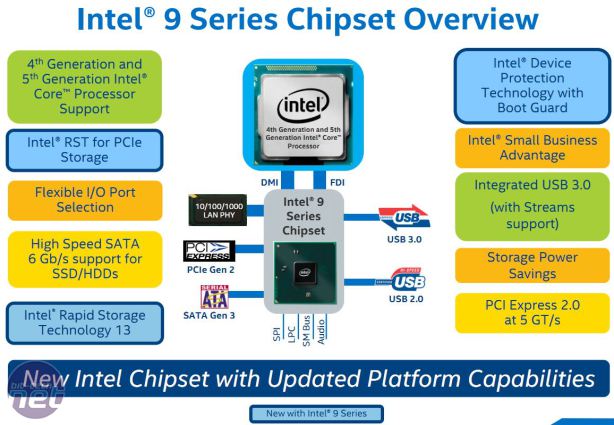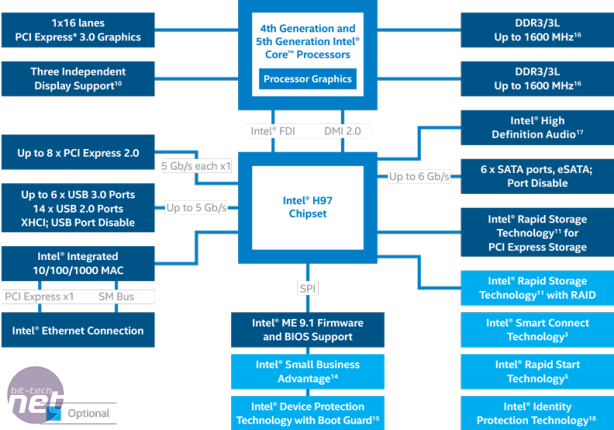The Intel 9-Series Chipsets Examined
Today marks the launch of Intel's new 9-Series chipsets, specifically Z97 and H97, which are the upgrades to Z87 and H87 respectively. There are only a few key new features to speak of, as the majority of features carry over unchanged from their implementation in the 8-Series chipsets, but we wanted to keep this overview of the new products separate from our other coverage and reviews so as to provide an easy reference point.The 9-Series chipsets are built to be used with Intel's LGA1150 socket. Z97 and H97 are the first chipsets to support all current and planned CPUs that use (or will use) this socket, including the 4th Generation (Haswell), new 4th Generation (Haswell Refresh, which includes the unlocked Devil's Canyon parts) and 5th Generation (Broadwell) of Intel Core processors.
Currently, it is unclear whether existing 8-Series motherboards will support Devil's Canyon and/or Broadwell CPUs through a BIOS update. Announcements such as this one from Asus tell us that at least some Haswell Refresh parts will be compatible with older motherboards, but it may well be a different case for the unlocked Devil's Canyon ones (i.e. the K-series CPUs) that will be of most interest to enthusiasts. We've reached out to Intel for clarification on the issue, and will update the article if and when we hear back.
The differences between Z97 and H97 are the same as they were in their 8-Series implementations, namely that only the enthusiast-grade Z97 platform fully and officially supports CPU ratio-based overclocking and multi-GPU set-ups. That said, last year saw ASRock introduce its Non-Z OC feature, which essentially re-unlocked CPU ratio-based overclocking on its H87 boards (assuming you had an unlocked K-series CPU to go with it). From what we've seen thus far, it's also present in at least some of the company's H97 motherboards. However, Intel claimed to be seeking a way to remove it through BIOS or Windows updates, so whether it will be available in the future, or whether it will work with Devil's Canyon or Broadwell parts remains to be seen.
For graphics support, PCIe 3.0 is again available with up to sixteen lanes, all of which are controlled by the CPU and not the chipset. However, there are differences between the chipsets as to how these lanes can be configured: in Z97, you can use one slot at x16 speed, two slots at x8 speed each, or three slots at x8/x4/x4 speeds, with these bandwidths enough to enable support for two-card SLI or three-card CrossFire. Premium motherboards may increase this to quad-card support, for example, with the use of PLX switching chips. In H97, however, only one slot can be used, so multi-GPU arrangements are off the cards, if you'll excuse the pun.
Other CPU-controlled components are the onboard graphics and system memory, and the specifications for these are unchanged. The onboard graphics can support up to three independent displays, while the CPU memory controller supports dual-channel DDR3 or DDR3L memory with a maximum of two DIMMs per channel. Officially, only speeds up to 1,600MHz are supported, but in reality you'll be able to use faster kits with most motherboards, with some that we've seen now offering support for up to 3,300MHz.
Once again, both chipsets have support for up to fourteen USB 2.0 ports and six USB 3.0 ports. Storage is catered for by the same six SATA 6Gbps ports as before as well, though you may see manufacturers bolstering their USB 3.0 and SATA 6Gbps ports through the use of additional controllers.

MSI MPG Velox 100R Chassis Review
October 14 2021 | 15:04













Want to comment? Please log in.